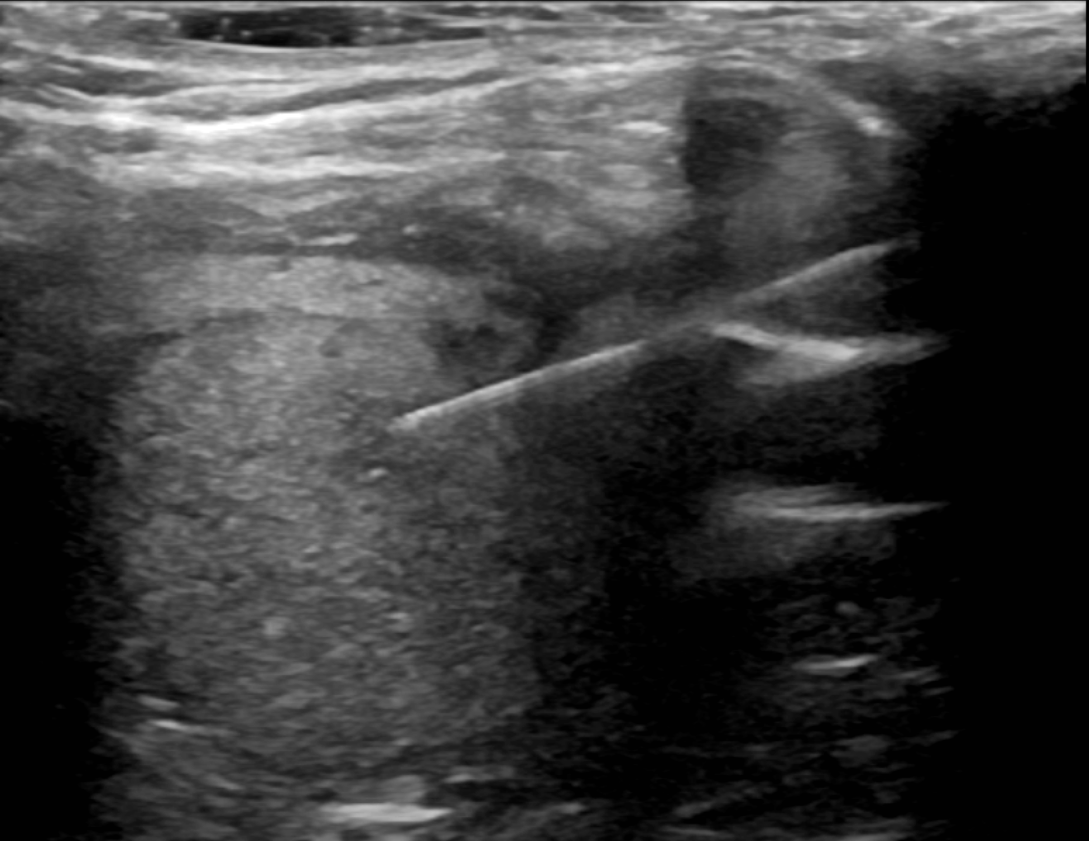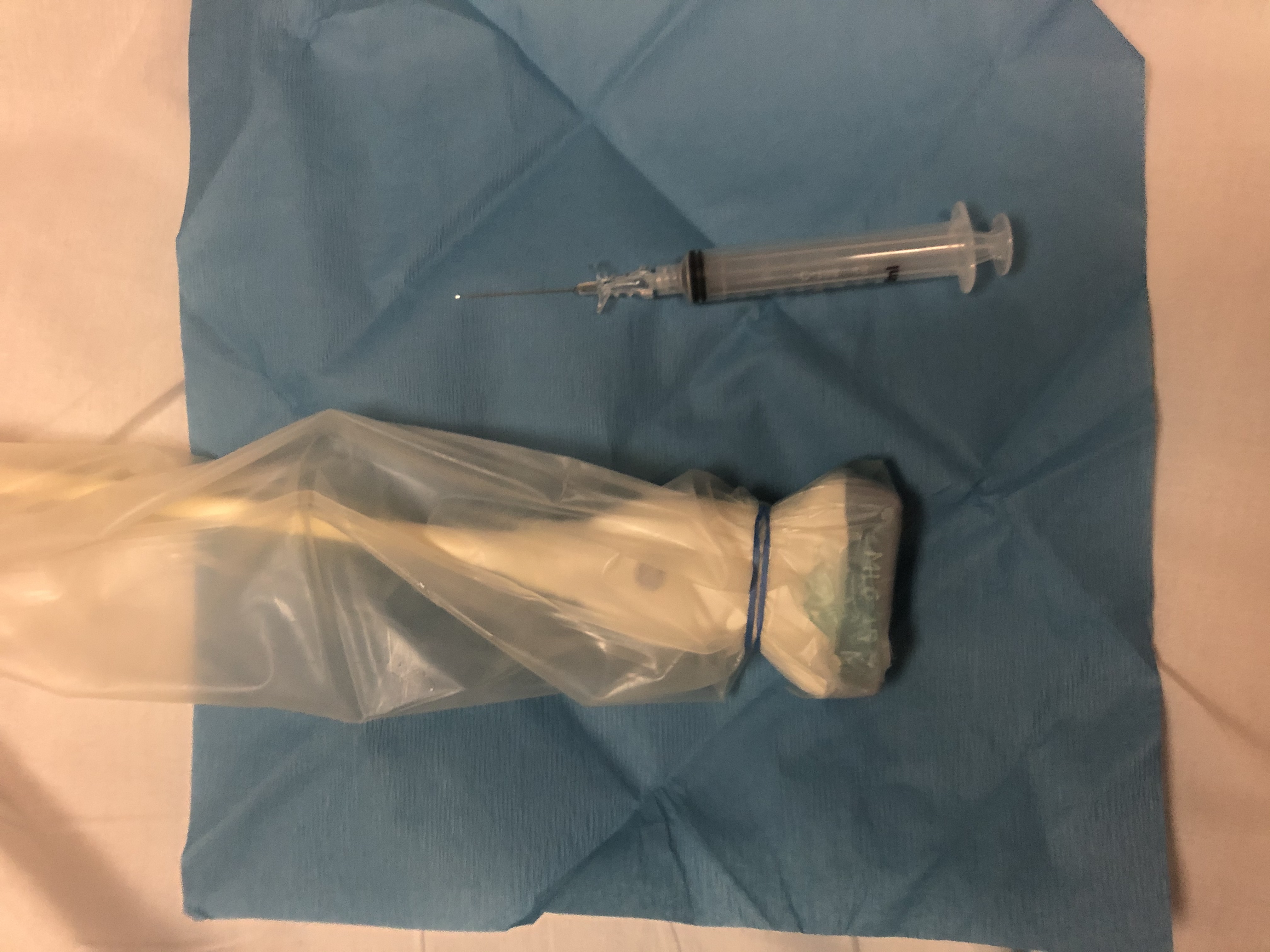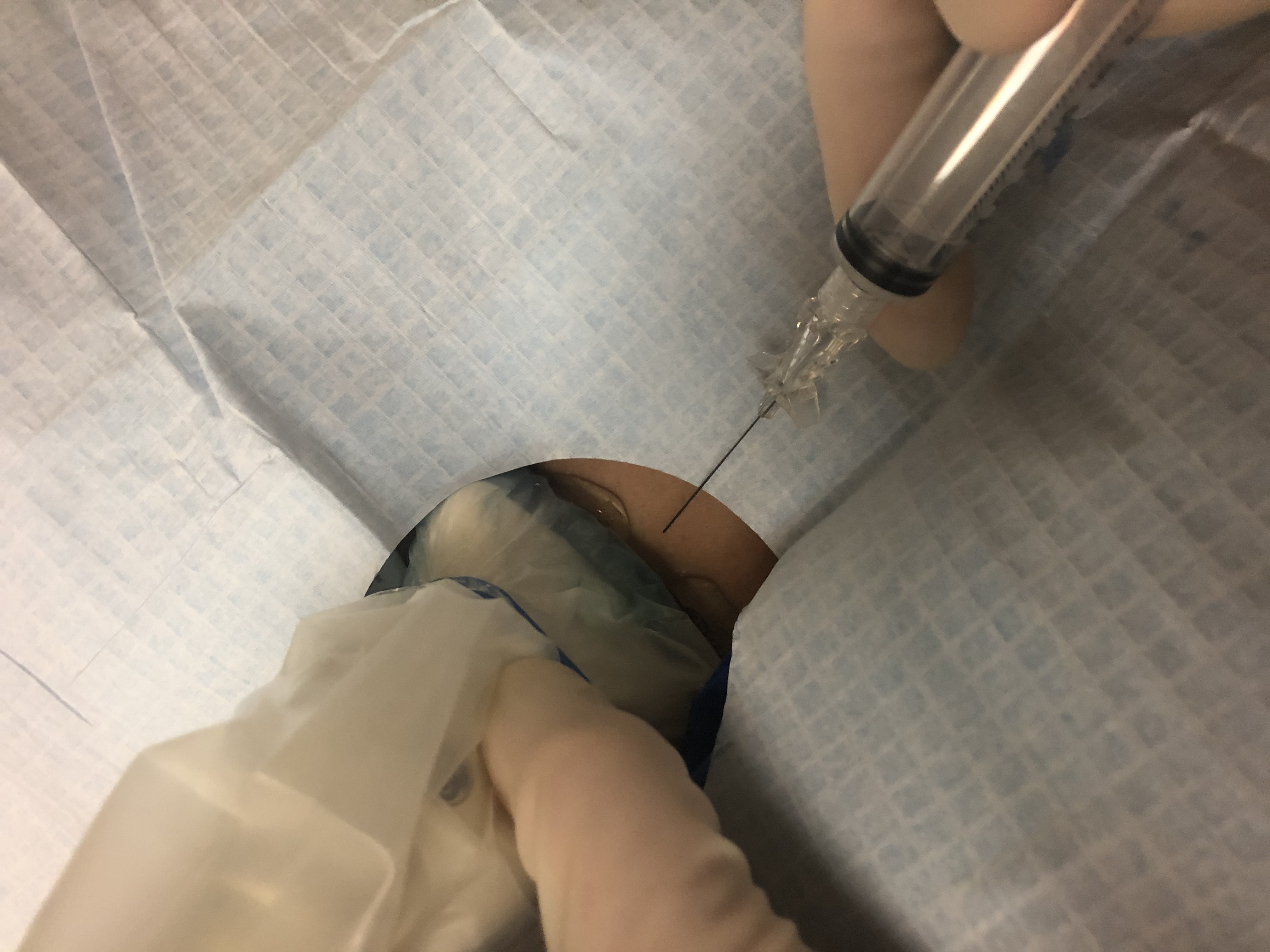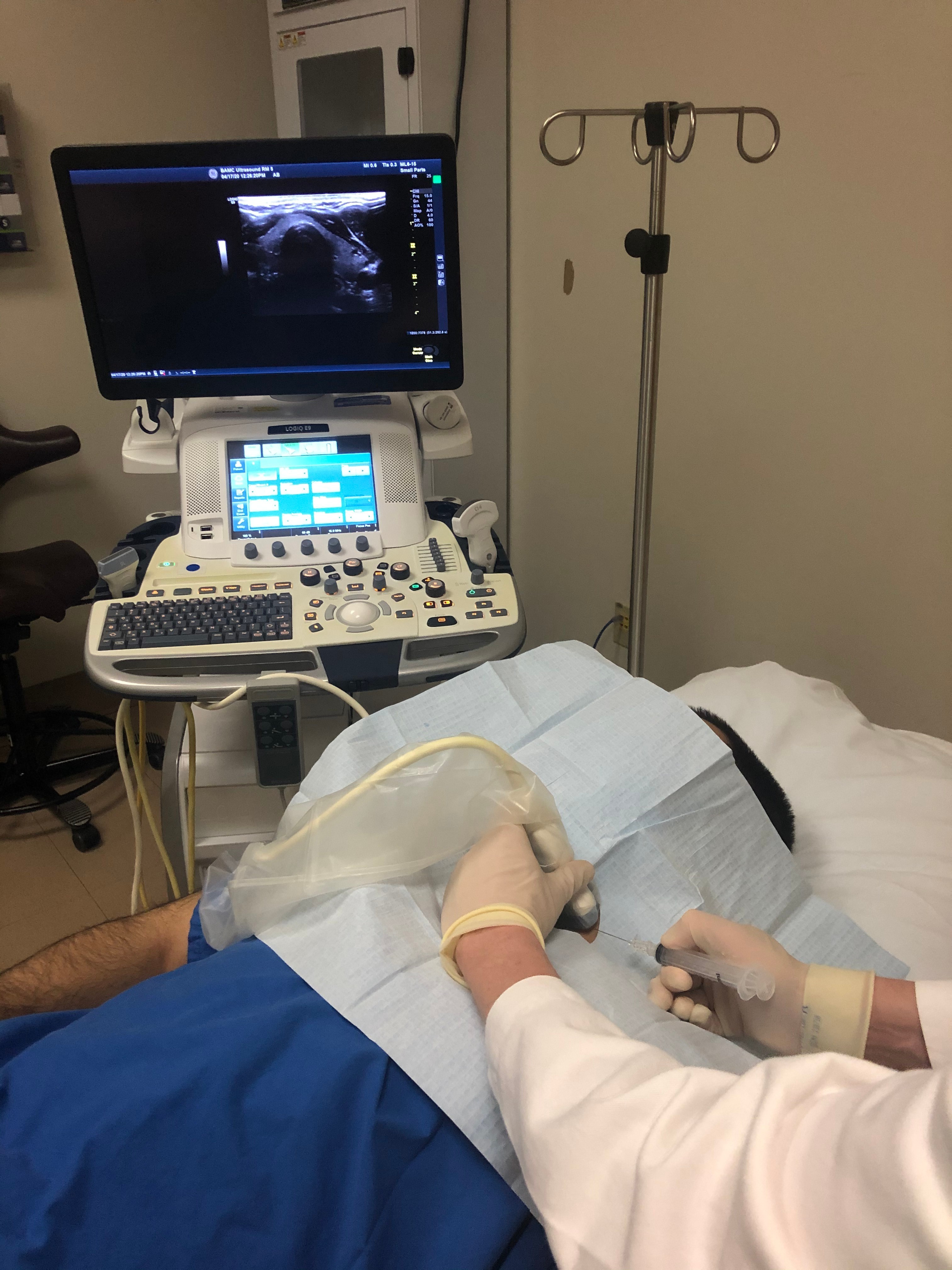[1]
Martin HE, Ellis EB. BIOPSY BY NEEDLE PUNCTURE AND ASPIRATION. Annals of surgery. 1930 Aug:92(2):169-81
[PubMed PMID: 17866350]
[2]
Walfish PG, Hazani E, Strawbridge HT, Miskin M, Rosen IB. Combined ultrasound and needle aspiration cytology in the assessment and management of hypofunctioning thyroid nodule. Annals of internal medicine. 1977 Sep:87(3):270-4
[PubMed PMID: 900669]
[4]
Chaudhary V, Bano S. Thyroid ultrasound. Indian journal of endocrinology and metabolism. 2013 Mar:17(2):219-27. doi: 10.4103/2230-8210.109667. Epub
[PubMed PMID: 23776892]
[5]
Frates MC, Benson CB, Charboneau JW, Cibas ES, Clark OH, Coleman BG, Cronan JJ, Doubilet PM, Evans DB, Goellner JR, Hay ID, Hertzberg BS, Intenzo CM, Jeffrey RB, Langer JE, Larsen PR, Mandel SJ, Middleton WD, Reading CC, Sherman SI, Tessler FN. Management of thyroid nodules detected at US: Society of Radiologists in Ultrasound consensus conference statement. Ultrasound quarterly. 2006 Dec:22(4):231-8; discussion 239-40
[PubMed PMID: 17146329]
Level 3 (low-level) evidence
[6]
Mandel SJ. Diagnostic use of ultrasonography in patients with nodular thyroid disease. Endocrine practice : official journal of the American College of Endocrinology and the American Association of Clinical Endocrinologists. 2004 May-Jun:10(3):246-52
[PubMed PMID: 15310543]
[7]
Papini E, Guglielmi R, Bianchini A, Crescenzi A, Taccogna S, Nardi F, Panunzi C, Rinaldi R, Toscano V, Pacella CM. Risk of malignancy in nonpalpable thyroid nodules: predictive value of ultrasound and color-Doppler features. The Journal of clinical endocrinology and metabolism. 2002 May:87(5):1941-6
[PubMed PMID: 11994321]
[8]
Rago T, Vitti P, Chiovato L, Mazzeo S, De Liperi A, Miccoli P, Viacava P, Bogazzi F, Martino E, Pinchera A. Role of conventional ultrasonography and color flow-doppler sonography in predicting malignancy in 'cold' thyroid nodules. European journal of endocrinology. 1998 Jan:138(1):41-6
[PubMed PMID: 9461314]
[9]
Hong YJ, Son EJ, Kim EK, Kwak JY, Hong SW, Chang HS. Positive predictive values of sonographic features of solid thyroid nodule. Clinical imaging. 2010 Mar-Apr:34(2):127-33. doi: 10.1016/j.clinimag.2008.10.034. Epub
[PubMed PMID: 20189077]
[10]
Moon WJ, Jung SL, Lee JH, Na DG, Baek JH, Lee YH, Kim J, Kim HS, Byun JS, Lee DH, Thyroid Study Group, Korean Society of Neuro- and Head and Neck Radiology. Benign and malignant thyroid nodules: US differentiation--multicenter retrospective study. Radiology. 2008 Jun:247(3):762-70. doi: 10.1148/radiol.2473070944. Epub 2008 Apr 10
[PubMed PMID: 18403624]
Level 2 (mid-level) evidence
[11]
Tessler FN, Middleton WD, Grant EG, Hoang JK, Berland LL, Teefey SA, Cronan JJ, Beland MD, Desser TS, Frates MC, Hammers LW, Hamper UM, Langer JE, Reading CC, Scoutt LM, Stavros AT. ACR Thyroid Imaging, Reporting and Data System (TI-RADS): White Paper of the ACR TI-RADS Committee. Journal of the American College of Radiology : JACR. 2017 May:14(5):587-595. doi: 10.1016/j.jacr.2017.01.046. Epub 2017 Apr 2
[PubMed PMID: 28372962]
[12]
Chng CL, Tan HC, Too CW, Lim WY, Chiam PPS, Zhu L, Nadkarni NV, Lim AYY. Diagnostic performance of ATA, BTA and TIRADS sonographic patterns in the prediction of malignancy in histologically proven thyroid nodules. Singapore medical journal. 2018 Nov:59(11):578-583. doi: 10.11622/smedj.2018062. Epub 2018 May 18
[PubMed PMID: 29774361]
[13]
Khadra H, Kholmatov R, Monlezun D, Kandil E. Do anticoagulation medications increase the risk of haematoma in ultrasound-guided fine needle aspiration of thyroid lesions? Cytopathology : official journal of the British Society for Clinical Cytology. 2018 Dec:29(6):565-568. doi: 10.1111/cyt.12608. Epub 2018 Aug 3
[PubMed PMID: 29969159]
[14]
Patel IJ, Rahim S, Davidson JC, Hanks SE, Tam AL, Walker TG, Wilkins LR, Sarode R, Weinberg I. Society of Interventional Radiology Consensus Guidelines for the Periprocedural Management of Thrombotic and Bleeding Risk in Patients Undergoing Percutaneous Image-Guided Interventions-Part II: Recommendations: Endorsed by the Canadian Association for Interventional Radiology and the Cardiovascular and Interventional Radiological Society of Europe. Journal of vascular and interventional radiology : JVIR. 2019 Aug:30(8):1168-1184.e1. doi: 10.1016/j.jvir.2019.04.017. Epub 2019 Jun 20
[PubMed PMID: 31229333]
Level 3 (low-level) evidence
[15]
Feldkamp J, Führer D, Luster M, Musholt TJ, Spitzweg C, Schott M. Fine Needle Aspiration in the Investigation of Thyroid Nodules. Deutsches Arzteblatt international. 2016 May 20:113(20):353-9. doi: 10.3238/arztebl.2016.0353. Epub
[PubMed PMID: 27294815]
[16]
Lo WC, Cheng PW, Wang CT, Yeh ST, Liao LJ. Pain levels associated with ultrasound-guided fine-needle aspiration biopsy for neck masses. Head & neck. 2014 Feb:36(2):252-6. doi: 10.1002/hed.23303. Epub 2013 Jun 1
[PubMed PMID: 23728803]
[17]
Leboulleux S, Borget I, Labro S, Bidault S, Vielh P, Hartl D, Dauchy S, Chougnet CN, Girard E, Azoulay S, Mirghani H, Berdelou A, Lumbroso J, Deandreis D, Baudin E, Schlumberger M, Laurent S. Frequency and intensity of pain related to thyroid nodule fine-needle aspiration cytology. Thyroid : official journal of the American Thyroid Association. 2013 Sep:23(9):1113-8. doi: 10.1089/thy.2012.0461. Epub 2013 Aug 27
[PubMed PMID: 23384309]
[18]
Song H, Wei C, Li D, Hua K, Song J, Maskey N, Fang L. Comparison of Fine Needle Aspiration and Fine Needle Nonaspiration Cytology of Thyroid Nodules: A Meta-Analysis. BioMed research international. 2015:2015():796120. doi: 10.1155/2015/796120. Epub 2015 Sep 29
[PubMed PMID: 26491689]
Level 1 (high-level) evidence
[19]
Maurya AK, Mehta A, Mani NS, Nijhawan VS, Batra R. Comparison of aspiration vs non-aspiration techniques in fine-needle cytology of thyroid lesions. Journal of cytology. 2010 Apr:27(2):51-4. doi: 10.4103/0970-9371.70737. Epub
[PubMed PMID: 21157549]
[20]
Guo YM, Huo JL, Qu R, Hu XC, Liu DS, Chen ZY, Hong W. [A comparison of fine needle nonaspiration cytology versus fine needle aspiration for thyroid nodules: a Meta-analysis]. Lin chuang er bi yan hou tou jing wai ke za zhi = Journal of clinical otorhinolaryngology, head, and neck surgery. 2018 Jun 5:32(11):868-872. doi: 10.13201/j.issn.1001-1781.2018.11.017. Epub
[PubMed PMID: 29921061]
Level 1 (high-level) evidence
[21]
Polyzos SA, Anastasilakis AD. Clinical complications following thyroid fine-needle biopsy: a systematic review. Clinical endocrinology. 2009 Aug:71(2):157-65. doi: 10.1111/j.1365-2265.2009.03522.x. Epub 2009 Jan 19
[PubMed PMID: 19170717]
Level 1 (high-level) evidence
[22]
Gharib H. Fine-needle aspiration biopsy of thyroid nodules: advantages, limitations, and effect. Mayo Clinic proceedings. 1994 Jan:69(1):44-9
[PubMed PMID: 8271850]
[23]
Lim H, Devesa SS, Sosa JA, Check D, Kitahara CM. Trends in Thyroid Cancer Incidence and Mortality in the United States, 1974-2013. JAMA. 2017 Apr 4:317(13):1338-1348. doi: 10.1001/jama.2017.2719. Epub
[PubMed PMID: 28362912]
[24]
Haugen BR, Alexander EK, Bible KC, Doherty GM, Mandel SJ, Nikiforov YE, Pacini F, Randolph GW, Sawka AM, Schlumberger M, Schuff KG, Sherman SI, Sosa JA, Steward DL, Tuttle RM, Wartofsky L. 2015 American Thyroid Association Management Guidelines for Adult Patients with Thyroid Nodules and Differentiated Thyroid Cancer: The American Thyroid Association Guidelines Task Force on Thyroid Nodules and Differentiated Thyroid Cancer. Thyroid : official journal of the American Thyroid Association. 2016 Jan:26(1):1-133. doi: 10.1089/thy.2015.0020. Epub
[PubMed PMID: 26462967]
[25]
Ito Y, Miyauchi A, Kihara M, Fukushima M, Higashiyama T, Miya A. Overall Survival of Papillary Thyroid Carcinoma Patients: A Single-Institution Long-Term Follow-Up of 5897 Patients. World journal of surgery. 2018 Mar:42(3):615-622. doi: 10.1007/s00268-018-4479-z. Epub
[PubMed PMID: 29349484]
[26]
Chiacchio S, Lorenzoni A, Boni G, Rubello D, Elisei R, Mariani G. Anaplastic thyroid cancer: prevalence, diagnosis and treatment. Minerva endocrinologica. 2008 Dec:33(4):341-57
[PubMed PMID: 18923370]
[27]
Lin B, Ma H, Ma M, Zhang Z, Sun Z, Hsieh IY, Okenwa O, Guan H, Li J, Lv W. The incidence and survival analysis for anaplastic thyroid cancer: a SEER database analysis. American journal of translational research. 2019:11(9):5888-5896
[PubMed PMID: 31632557]





